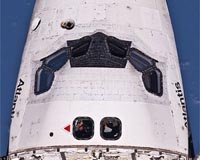 |
Greenbelt MD (SPX) May 17, 2010 There's a new "dawn" for science experiments aboard the International Space Station. A Russian-built Mini-Research Module-1 launched on space shuttle Atlantis' STS-132 mission. The module, known as Rassvet - which translates as "dawn" - will be used for science research and cargo storage. It also will provide an additional docking port for Russian Soyuz and Progress vehicles at the space station. Weighing more than 11,000 pounds and measuring 19.7 feet in length and 7.7 feet in diameter, Rassvet will host a wide variety of biotechnology and biological science experiments and fluid physics and educational research. The module contains a pressurized compartment with eight workstations equipped with facilities such as a glovebox to keep experiments separated from the in-cabin environment; two incubators to accommodate high- and low-temperature experiments; and a vibroprotective platform to protect payloads and experiments from onboard vibrations. The module contains four other workstations, complete with mechanical adapters, to install payloads into roll-out racks and shelves. "Our science capabilities are going to be greater than ever on the space station," said Igor Sorokin, deputy head of the Space Station Utilization Center at S.P. Korolev Rocket and Space Corporation Energia. "From the standpoint of science capabilities to be provided, as well as payload integration principles to be applied, this module can be considered as an intermediate one - even in its "mini" version - between the older Russian Service Module and future Multipurpose Laboratory Module, which is targeted for the station in 2012. We have applied some advanced principles of research facilities development and integration as compared with the Service Module, which will increase the utilization efficiency of the Russian segment." Some benefits include conducting experiments such as Conjugation, which studies the exchange of genetic material in microgravity to develop strains producing new target proteins to fight disease. Another experiment, Kristallizator, allows large protein crystals to grow in orbit to better determine their 3-D structure. The results could be used in biology, medicine and pharmacology. "Rassvet provides important new real estate for experiments to be conducted on the space station, and will be a cornerstone of Russian laboratory facilities for years to come," said Julie Robinson, International Space Station program scientist at Johnson Space Center in Houston. "This new module enhances the station's research capabilities and enables new investigations to be performed." Rassvet was developed at S.P. Korolev Rocket and Space Corporation Energia in Russia.
Share This Article With Planet Earth
Related Links NASA's Marshall Space Flight Center Station at NASA Station and More at Roscosmos S.P. Korolev RSC Energia Watch NASA TV via Space.TV Space Station News at Space-Travel.Com
 Atlantis docks with space station on final mission
Atlantis docks with space station on final missionCape Canaveral, Florida (AFP) May 16, 2010 The space shuttle Atlantis linked up with the International Space Station (ISS) Sunday for its final rendezvous. NASA said Atlantis and its crew of six astronauts successfully docked with the orbiting space lab at 10:28 am (1428 GMT) about 220 miles (350 kilometers) above the South Pacific. After an hour to check the soundness of the seal, the shuttle and station crews were to open the h ... read more |
|
| The content herein, unless otherwise known to be public domain, are Copyright 1995-2010 - SpaceDaily. AFP and UPI Wire Stories are copyright Agence France-Presse and United Press International. ESA Portal Reports are copyright European Space Agency. All NASA sourced material is public domain. Additional copyrights may apply in whole or part to other bona fide parties. Advertising does not imply endorsement,agreement or approval of any opinions, statements or information provided by SpaceDaily on any Web page published or hosted by SpaceDaily. Privacy Statement |